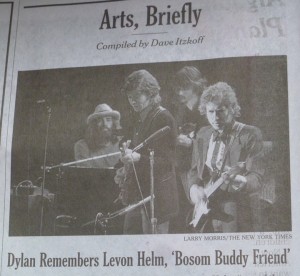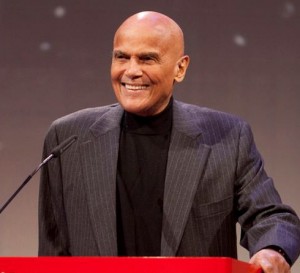It often takes me a few days to catch up to the weekend papers, so today, on glancing at the New York Times of Saturday, April 21, I was glad to see they’d featured Bob Dylan’s eulogy for Levon Helm that I also cited on this blog in Reflecting on The Band’s Break-up and Levon’s Death. Oddly, with the benefit of time passing, I often discover mistakes in the paper days after publication, as happened some months ago with Times coverage of the Romneys’ horses. Sure enough, as I began to read last Saturday’s story I was surprised to see that the photograph of Dylan and The Band they used with their item didn’t actually include Levon in it. Clearly, others had noticed the error before me, because on the Times website I’ve found this correction accompanying the article where the erroneous photo has been removed.
Because of an editing error, a report in the “Arts, Briefly” column on Saturday about Bob Dylan’s recollections of collaborating with Levon Helm, the drummer and singer who died last week at 71, erroneously included Mr. Helm among the musicians pictured at a 1974 performance. Another drummer, who was not identified, was shown with the group; Mr. Helm was not pictured.
As corrections too often do, this one piles error on top of error, with the reference to “another drummer” an additional mistake. First, the bearded person seated in a hat, who the Times wanted readers at first to incorrectly assume was Levon, is not some anonymous walk-on, but actually Richard Manuel, member of The Band going back to their earliest days when they were called The Hawks. Manuel ordinarily played piano (the instrument he is actually seated at in the Times photo), but would slide over to drums when Levon played mandolin or guitar. Unfortunately, as can be seen in my photos of the item, it had no caption at all, and the Times didn’t ID any of the musicians, apparently content to let readers infer that Levon Helm was in the shot. Had the brief carried a caption this error-riddled series of cascading confusions might’ve never been set in motion, or maybe it would have anyway, since it’s obvious that whoever was editing this section of the paper knew little about The Band. To sum it up, the person vaguely implied in the Times brief to be Levon was not him, and the person described in the correction was not at the drums in the photo, but at the piano. Presumably, Levon was on stage, seated at his drum kit, out of the frame of Times photographer Larry Morris’s lens, or was cropped out of the image at some point.
As journalist and author Craig Silverman points out in his fine book, Regret the Error, which I edited and published with him in 2008, media errors are often quite avoidable, and the Times‘ multiple failures here surely fall into that category. As shown in the extensive coverage of Levon’s terminal illness and death, it is clear that there are scores of photos of Bob Dylan and The Band that include him, such as the one shown below from the Los Angeles Times. It’s a pity they couldn’t have found one like it that included Levon, either in the print edition, or at worst, even later, online where no photo now appears. An error in an obituary or a eulogy is one of the most serious mistakes a media outfit can make, and the Times royally messed up here. They owe their readers better, both in print, and online.
// click through to see all photos and captions . . .
 Horst Faas, the great photojournalist who covered conflicts in Bangla Desh, the Congo, and most famously Vietnam, died last week at age 79. In the 1960s he was a colleague to David Halberstam and Peter Arnett, among other notable reporters and correspondents. Faas’s longtime Associated Press colleague Richard Pyle has written the AP’s obituary and a personal remembrance of his dear friend and colleague, both of which are posted on the New York Times‘s superb Lens blog. With warmth and affection Pyle calls this period of his life “The Story That Never Ends.” His personal essay includes an account of the final reporting trip the two friends made together, in 1998, searching for the remains of four photographers–Larry Burrows of Life magazine, Kent Potter of United Press International, Keisaburo Shimamoto of Newsweek, and Henri Huet of Associated Press–all of whom were aboard a helicopter over Laos that crashed in 1971. In 2004 as co-authors the two published, Lost in Laos: A True Story of Tragedy, Mystery, and Friendship, their book on this incident and its aftermath. All photos for this post are credited to Horst Faas and/or the AP, gratefully borrowed for reproduction here so my readers can see Faas’s genius and his empathy, before seeing even more of his work via the key links to Pyle’s obituary and his personal remembrance. Click through to full post for all photos / / more . . .
Horst Faas, the great photojournalist who covered conflicts in Bangla Desh, the Congo, and most famously Vietnam, died last week at age 79. In the 1960s he was a colleague to David Halberstam and Peter Arnett, among other notable reporters and correspondents. Faas’s longtime Associated Press colleague Richard Pyle has written the AP’s obituary and a personal remembrance of his dear friend and colleague, both of which are posted on the New York Times‘s superb Lens blog. With warmth and affection Pyle calls this period of his life “The Story That Never Ends.” His personal essay includes an account of the final reporting trip the two friends made together, in 1998, searching for the remains of four photographers–Larry Burrows of Life magazine, Kent Potter of United Press International, Keisaburo Shimamoto of Newsweek, and Henri Huet of Associated Press–all of whom were aboard a helicopter over Laos that crashed in 1971. In 2004 as co-authors the two published, Lost in Laos: A True Story of Tragedy, Mystery, and Friendship, their book on this incident and its aftermath. All photos for this post are credited to Horst Faas and/or the AP, gratefully borrowed for reproduction here so my readers can see Faas’s genius and his empathy, before seeing even more of his work via the key links to Pyle’s obituary and his personal remembrance. Click through to full post for all photos / / more . . . 








